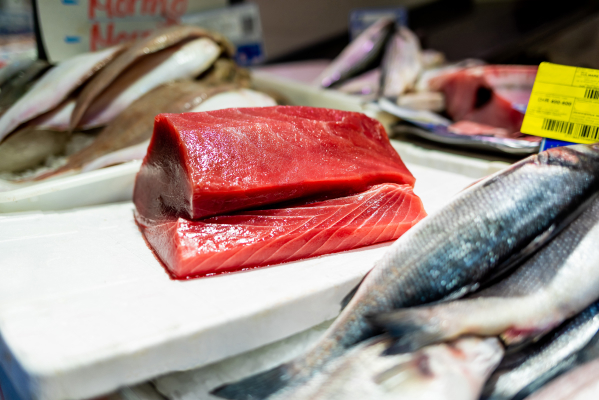Mythical Tuna
The Atlantic bluefin tuna is the largest one of the kind. Its scientific name is Thunnus thynnus. It’s the star product of the food supply from Cádiz. Since long ago, it’s been caught off the coast of Cádiz, as it passes through the Strait of Gibraltar, using the fishing method known as almadraba. Highly valued by the world gastronomic market, wild tuna is especially popular in Japan for their raw fish dishes. It’s exquisite like no other tuna, and when it arrives at the table… the myth is being served!
The bluefin tuna, also known as wild tuna, atún rojo (common name in Spain) or cimarrón (in the north of Spain), weighs between 250 and 700 kg and can exceed 3 metres in length. It spends the winter nourishing itself in the North Atlantic and when spring arrives, around March, it embarks on its spectacular migration towards the warm waters of the Mediterranean to spawn. They approach the coast of Cádiz in large masses or shoals taking advantage of the strong sea currents of the Strait of Gibraltar.

Thunnus thynnus has a very characteristic colour, as it has an intense dark blue back that contrasts with the whitish tones of the belly. Its flesh has reddish tones and is very tasty, a real delicacy! It’s one of the few fish that is cut into pieces, a process known as ronqueo, because of the sound it makes (ronqueo in Spanish means snorking).
Bluefin tuna fishing is subject to maximum catch quotas set by the International Commission for the Conservation of Atlantic Tunas (ICCAT).

It’s an impressive, purely instinctive journey of these great swimmers, as they return to their place of birth. The shoals that move closer to the coast are those that fall into the complex system of almadraba nets where they’re caught. Towns such as Barbate, Conil de la Frontera, Zahara de los Atunes or Tarifa are still deeply linked to tuna fishing through their traps – the way it’s been since long ago.
In addition to being consumed fresh during the season, wild tuna is available all year round thanks to the existence of several companies in Cádiz that freeze it at -60º C, just freshly caught, keeping its organoleptic qualities intact. This advanced conservation system guarantees the supply of this noble product to restaurants all over the world, all year round.

